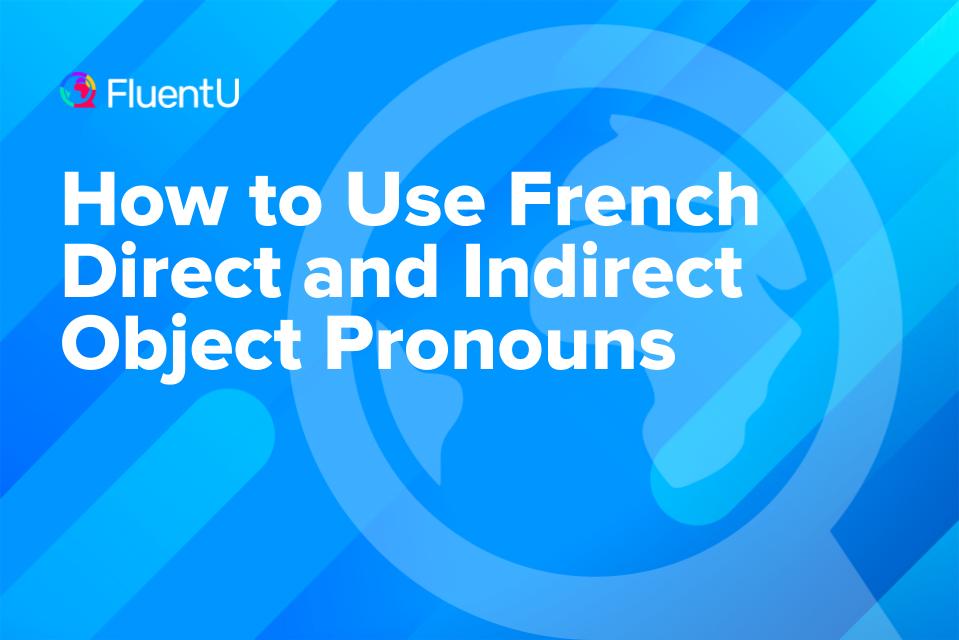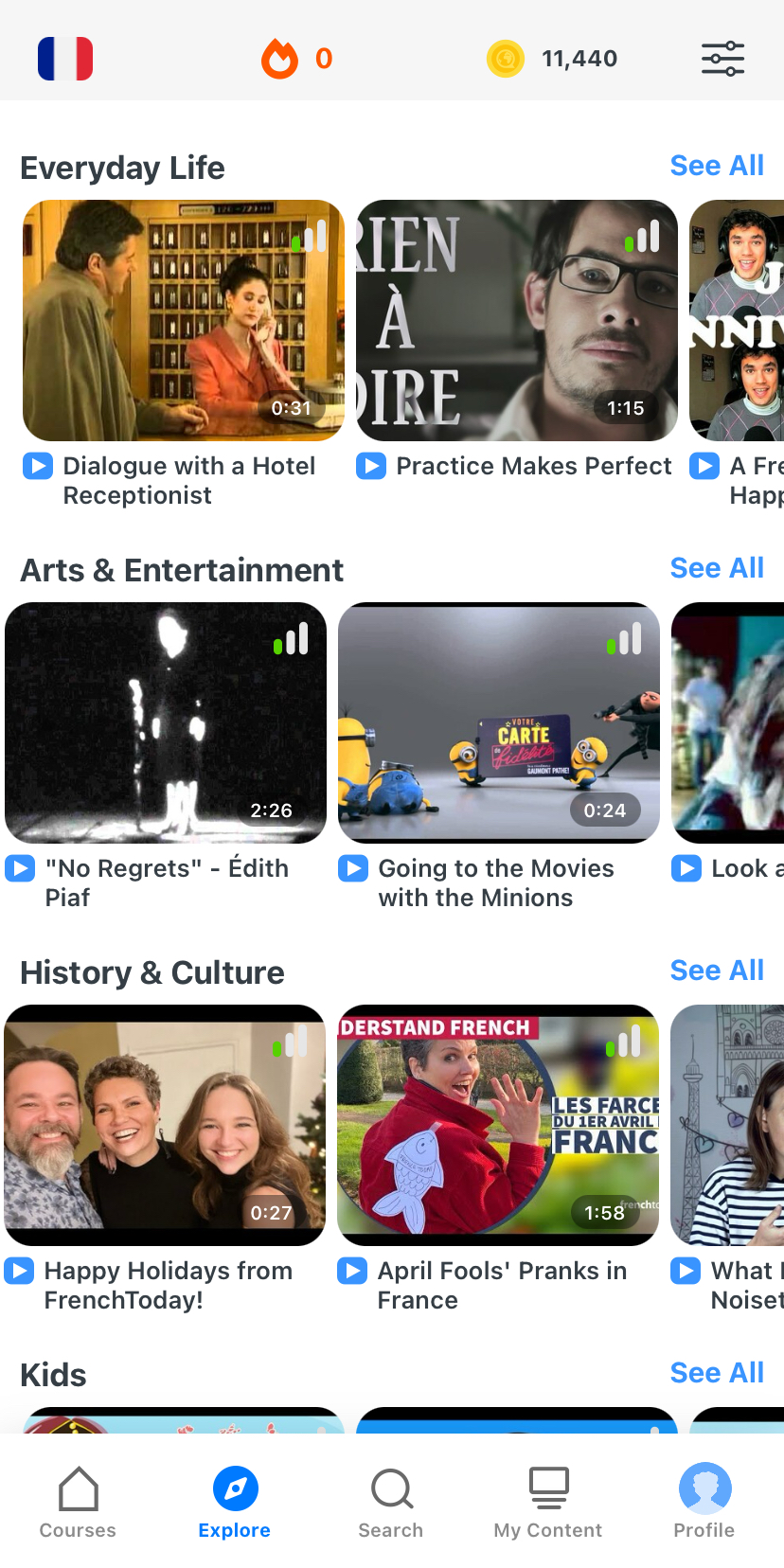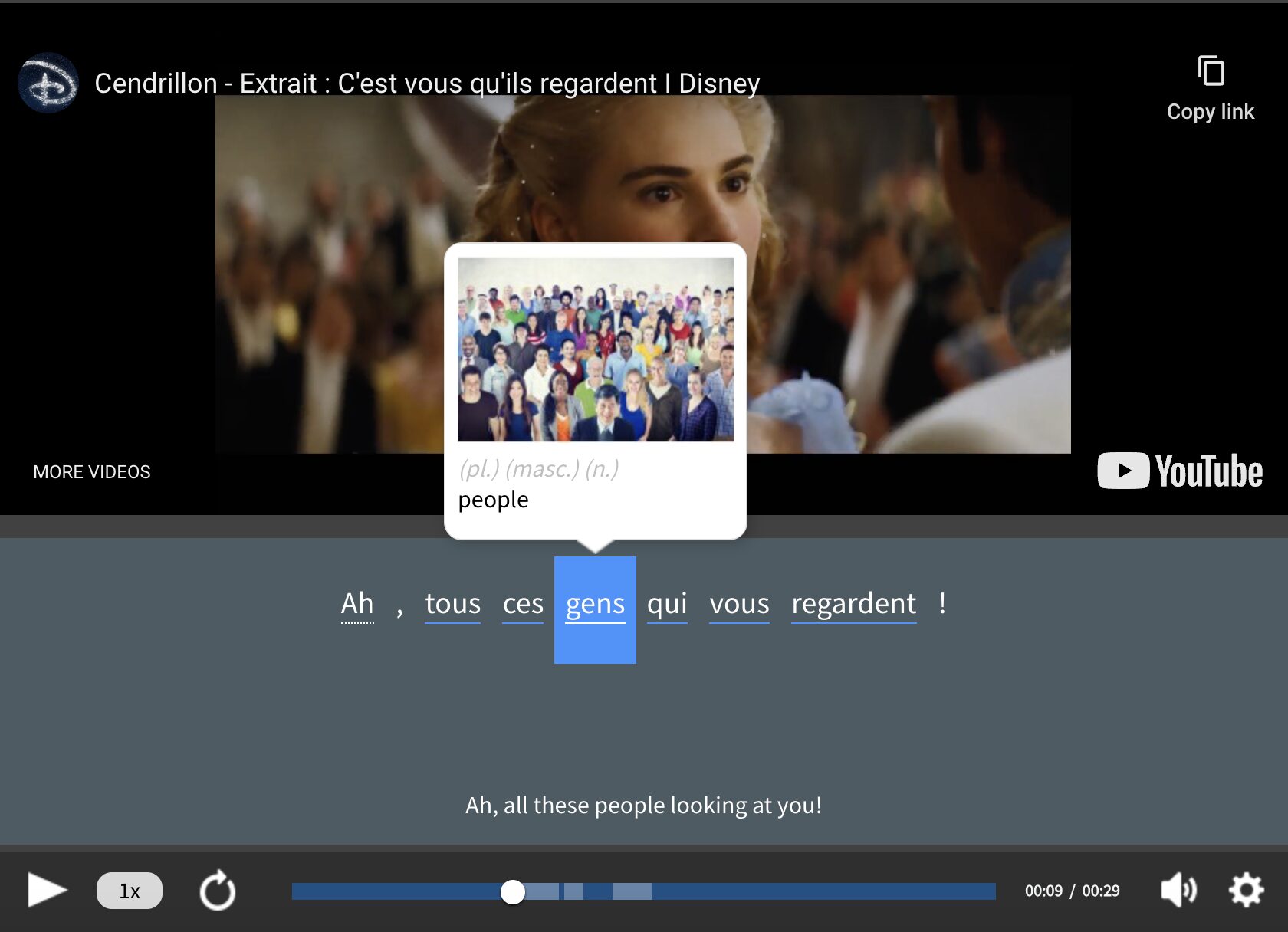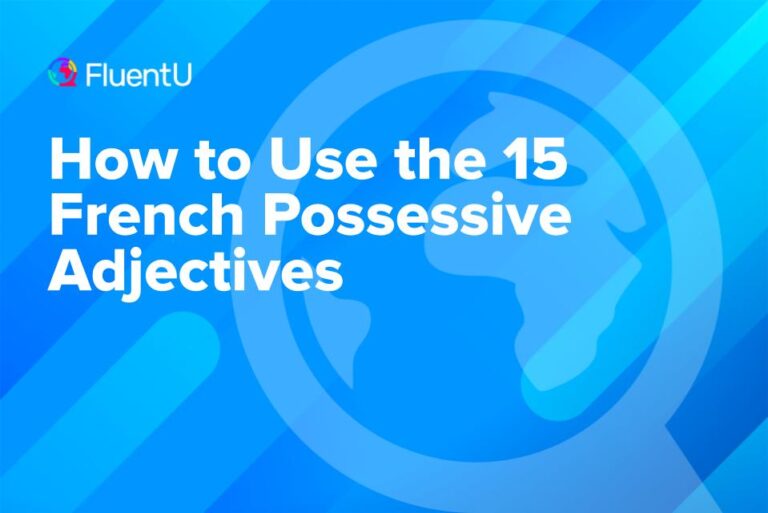How to Use French Direct and Indirect Object Pronouns

Pronouns are essential to smooth-flowing, unstilted French. Today, we’re going to focus specifically on object pronouns.
In a nutshell, direct object pronouns are the receivers of the action in the sentence, while indirect object pronouns show to whom or for whom the action is done.
Download: This blog post is available as a convenient and portable PDF that you can take anywhere. Click here to get a copy. (Download)
Direct Object Pronouns
First things first: To use direct object pronouns, you have to be able to identify the direct object in a sentence.
A direct object is a person or a thing that receives the action of a verb.
Take this sentence:
Marie lit le journal. (Marie reads the newspaper.)
Le journal (the newspaper) is the direct object in this case. It’s receiving Marie’s action (reading).
Here’s another:
Je vois Mireille. (I see Mireille.)
The direct object in this case is Mireille.
A good way to identify the direct object in a sentence is to learn to ask questions that start with “what” or “who”:
What is Marie reading? The newspaper.
Who do I see? Mireille.
Direct object pronouns replace direct object nouns. They must take into account the gender and quantity of the noun they replace.
Here they are:
How to Use Direct Object Pronouns
Let’s replace the direct objects in the previous sentences with direct object pronouns:
Marie lit le journal.
(Marie reads the newspaper.)
Marie le lit.
(Marie reads it.)
Je vois Mireille.
(I see Mireille.)
Je la vois.
(I see her.)
The direct object pronoun goes in front of the conjugated verb. This applies to both simple (present, simple past, etc.) and compound tenses (the compound past, the past perfect or pluperfect, etc.)
In the case of compound tenses, which are made up of two elements, être (to be) or avoir (to have) and a past participle, the direct object pronoun goes in front of the helping verb.
So remember Marie and her newspaper? Here she is again, this time in the passé composé (compound past):
Marie a lu le journal.
(Marie read the newspaper.)
Marie l’a lu.
(Marie read it.)
Keep in mind, though, that when a direct object precedes the passé composé or any other compound tense, the past participle has to agree with the direct object.
J’ai vu Mireille.
(I saw Mireille.)
Je l’ai vue.
(I saw her.)
Here we have to add the e at the end of the past participle because Mireille is feminine singular. When the person or object is masculine singular, nothing changes.
However, we do add an s to the past participle in the case of a masculine plural direct object pronoun:
J’ai vu Thomas et Jean.
(I saw Thomas and John.)
Je les ai vus.
(I saw them.)
When the direct object pronoun refers to a group that is feminine and plural, we add both an e and an s to the past participle.
J’ai vu Mireille et Marie.
(I saw Mireille and Marie.)
Je les ai vues.
(I saw them.)
Negation and the Direct Object Pronoun
When you negate simple tenses, like the present, future, imperfect and passé simple (simple past), object pronouns are placed between the ne and the verb:
Marie ne lit pas le journal.
(Marie doesn’t read the newspaper.)
Marie ne le lit pas.
(Marie doesn’t read it.)
Je ne vois pas Mireille.
(I don’t see Mireille.)
Je ne la vois pas.
(I don’t see her.)
In compound tenses, object pronouns are placed between the ne and the auxiliary verb. The same rules of agreement apply.
Marie n’a pas lu le journal.
(Marie did not read the newspaper.)
Marie ne l’a pas lu.
(Marie didn’t read it.)
Je n’ai pas vu Mireille.
(I didn’t see Mireille.)
Je ne l’ai pas vue.
(I didn’t see her.)
Indirect Object Pronouns
Let’s move on to indirect object pronouns.
An indirect object refers to the noun to/for whom the action of the verb is occurring. An indirect object is usually preceded by pour (for) or à (to, at). The indirect object responds to the question “To whom?” or “For whom?”
Marianne parle à Jeanne. (Marianne speaks to Jeanne.)
To whom does Marianne speak? To Jeanne. Jeanne is the indirect object.
Jacques écrit à Jacqueline. (Jacques writes to Jacqueline.)
To whom does Jacques write? To Jacqueline. Jacqueline is therefore the indirect object.
Here are the indirect object pronouns:
They replace the indirect object. So far so good? Okay, now get this:
While the indirect object can be people or things, indirect object pronouns can only refer to people or animate nouns (animate meaning living and breathing, like a cat or a turtle).
When the direct object is inanimate, we use the adverbial pronoun y or an indefinite demonstrative pronoun.
Here’s how indirect object pronouns work:
Marianne parle à Jeanne.
(Marianne talks to Jeanne.)
Marianne lui parle.
(Marianne talks to her.)
Jacques écrit à Jacqueline.
(Jacques writes to Jacqueline.)
Jacques lui écrit.
(Jacques writes to her.)
When we use lui (him or her), a sentence can be ambiguous. We can make things more clear by adding the preposition à + the stressed pronoun elle (her). We place it after the verb.
Marianne lui parle à elle. (Marianne speaks to her.)
Jacques lui écrit à elle. (Jacques writes to her.)
In the case of compound tenses, the indirect object pronoun usually goes before the helping verb.
Also, just be aware that there are certain verbs that do not work with indirect object pronouns. These require another type of pronoun, usually an adverbial or indefinite demonstrative pronoun.
Putting Direct Objects and Indirect Objects Together
When a sentence contains both a direct and an indirect object, they can each be replaced with direct and indirect object pronouns, respectively.
Let’s take a look at a couple of examples.
Nicolas achète un café pour moi. (Nicolas buys a coffee for me.)
What does Nicolas buy? Coffee. Coffee is the direct object.
Since café is masculine and singular, it gets replaced by the direct object pronoun le. For whom does Nicolas buy coffee? For me, the indirect object. The French indirect object pronoun is me.
In the case of the first and second person, the direct object pronoun is usually closest to the verb of which it is the object.
Nicolas me l’achète. (Nicolas buys it for me.)
In the case of the third person singular and plural, the order changes. This time, the indirect object pronoun is closest to the verb.
Here’s an example:
Nicolas achète le café pour Perrine. (Nicolas buys the coffee for Perrine.)
“Coffee” is the direct object. This time, Perrine (third person singular) is the indirect object. Perrine will be replaced by lui (her).
When we use pronouns, the sentence becomes:
Nicolas le lui achète. (Nicolas bought it for her.)
With enough practice, you’ll get the hang of using the correct direct and indirect object pronouns in French!
Since they pop up so often in conversation, you can immerse in them naturally through French media. See if you can identify all the pronouns in this “Friends” clip from our YouTube channel:
You can find more authentic French videos like this on the FluentU program.
FluentU takes authentic videos—like music videos, movie trailers, news and inspiring talks—and turns them into personalized language learning lessons.
You can try FluentU for free for 2 weeks. Check out the website or download the iOS app or Android app.
P.S. Click here to take advantage of our current sale! (Expires at the end of this month.)
Using the Imperative Form with Direct and Indirect Object Pronouns
The French imperative form can be used to express a desire, give advice, make a request, make a recommendation or give an order.
It’s important to note that:
- The imperative only applies to tu (you, singular informal), nous (we) and vous (you, plural or formal) verb forms.
- The imperative conjugations for nous and vous are the same as the conjugations in the present indicative.
- The tu form of the imperative is usually the indicative minus the final s.
Here are some examples:
- Mangez la soupe ! (Eat the soup!)
- Lisez la deuxième page ! (Read the second page!)
- Mange les pâtes ! (Eat the pasta!)
- Lisons le livre ensemble. (Let’s read the book together.)
The negative imperative, in which you tell someone not to do something, is formed by adding ne in front of the verb and pas (or another negative adverb) on the other side.
- Ne lisez pas la deuxième page. (Don’t read the second page.)
- Ne mange pas les pâtes. (Don’t eat the pasta.)
- Ne lisons pas le livre ensemble. (Let’s not read the book together.)
Now, let’s move on to using indirect object and direct object pronouns with the imperative.
In the affirmative imperative, pronouns follow the verb and are connected with hyphens:
Mangez la soupe !
(Eat the soup!)
Mangez-la !
(Eat it!)
Lisez la deuxième page !
(Read the second page!)
Lisez-la !
(Read it!)
Lisons le livre ensemble.
(Let’s read the book together.)
Lisons-le !
(Let’s read it!)
The pronouns me and te change to moi and toi in the imperative form:
Laisse-moi tranquille. (Leave me alone.)
Regarde-toi dans le miroir. (Look at yourself in the mirror.)
When a sentence has a direct object and an indirect object, the order of pronouns is a little bit funky. For the affirmative imperative, the order of direct object and indirect object pronouns is as follows:
Le, la, les/moi, toi, lui/nous, vous, leur
Expliquons l’equation à Thomas et Lilly ! (Let’s explain the equation to Thomas and Lilly!)
In this sentence, the equation is the direct object and Thomas and Lilly are the indirect objects. With pronouns, the sentence becomes:
Expliquons-la-leur ! (Let’s explain it to them!)
For the negative imperative, the negative structure—such as ne…pas (not) or ne…jamais (never)—surrounds the pronouns and the verb. There are no hyphens and the order of the direct and indirect object pronouns is a bit different:
me, te, nous, vous/le, la, les/lui, leur
N’expliquons pas l’equation à Thomas et Lilly.
(Let’s not explain the equation to Thomas and Lilly.)
Ne la leur expliquons pas !
(Let’s not explain it to them!)
And there you have it!
With object pronouns under your belt, you’re well on your way to becoming a French grammar boss.
Download: This blog post is available as a convenient and portable PDF that you can take anywhere. Click here to get a copy. (Download)
And One More Thing...
If you like learning French at your own pace and from the comfort of your device, I have to tell you about FluentU.
FluentU makes it easier (and way more fun) to learn French by making real content like movies and series accessible to learners. You can check out FluentU's curated video library, or bring our learning tools directly to Netflix or YouTube with the FluentU Chrome extension.
One of the features I find most helpful is the interactive captions—you can tap on any word to see its meaning, an image, pronunciation, and other examples from different contexts. It’s a great way to pick up French vocab without having to pause and look things up separately.
FluentU also helps reinforce what you’ve learned with personalized quizzes. You can swipe through extra examples and complete engaging exercises that adapt to your progress. You'll get extra practice with the words you find more challenging and even be reminded you when it’s time to review!
You can use FluentU on your computer, tablet, or phone with our app for Apple or Android devices. Click here to take advantage of our current sale! (Expires at the end of this month.)











